► The changing face of the GT
► McLaren, Honda, Ferrari
► How best to spend your big bucks?
If, in the ’60s, you needed to drive far, fast and in style, you reached for your Ferrari Daytona, the definitive GT. But, now, the GT has many faces.
Pre-flight briefing: McLaren GT
Why is it here?
McLaren’s first ever grand tourer, built on the same mid-engined foundations as any other McLaren. Can a convincingly luxury GT experience really be born of sports car ingredients?
Any clever stuff?
The familiar carbon tub evolves with an upper ‘Touring’ rear structure. Together with a slightly lower engine, it’s key to the 420-litre rear load area. The 4.0-litre V8 gets new twin turbos, and there’s Proactive damping from the 720S, which learns from previous scenarios. All-new nav with real-time traffic info too.
Which version is this?
Choose Standard, Pioneer or Luxe interior. Our £10k Luxe brings memory heated seats, power-adjusted steering column, softgrain aniline leather and SuperFabric luggage bay floor.
Pre-flight briefing: Ferrari Portofino
Why is it here?
The Portofino costs similar money to the genre-bending McLaren but is a trad GT. A front-engined V8 with plus-two rear seats, a normal boot, and even a folding hardtop roof, the Portofino better delivers the grand touring brief – but is it actually a better grand tourer?
Any clever stuff?
How about Variable Torque Management that drip-feeds the twin-turbocharger torque through the lower gears (for that naturally-aspirated feel), a third-generation e-differential to grip or skid on demand, and a hardtop that drops in 14 seconds on the move? There’s a 10.25-inch infotainment screen, though don’t forget to add £2.4k for Apple CarPlay.
Which version is this?
It’s the one and only, though our car manages to cost £249k: £12k carbon exterior pack, £7k paint, £3k adaptive dampers and £3.5k front/rear parking cameras are among the biggies.
Pre-flight briefing: Honda NSX
Why is it here?
Honda’s high-tech supercar now with updates that mostly focus on sharper style or sharper handling, with stiffer bushings and anti-roll bars, grippier tyres and some laptop trickery for the all-wheel drive, electric steering, ESP and adaptive dampers.
Any clever stuff?
Plenty. It’s like the Lost Decade never happened, and Honda kept evolving the original NSX to maintain Japan’s high-tech leadership. A transversely mounted twin-turbo 3.5-litre V6 is boosted by a single electric motor at the rear and twin electric motor on the front axle. The Honda’s the only car here with all-wheel drive and the only one with pure electric capability.
Which version is this?
There’s only one version, which now has electrically adjusted seats and upgraded ELS audio. Our car gets £25,000 of extras, including carbonfibre everything – carbon- ceramic brakes, carbon exterior pack, carbon engine bay…
McLaren GT: sports car meets plush

Either McLaren has been thinking outside the box or it hasn’t read the script, because the specification of this new McLaren GT veers so far off-piste from a trad grand tourer’s that someone should probably call mountain rescue. Not that the GT’s ingredients are radical, because it follows the same formula as every McLaren produced since 2011’s MP4-12C, and its building blocks trip from the tongues of car literates like a primary schooler might recite the alphabet: carbonfibre tub, mid- mounted twin-turbo V8, seven-speed-dual clutch gearbox, dihedral doors.
You’ll pay from £163,000, so the GT’s affordable in a McLaren context, and comparable money to the 570S Spider with which it shares so much, though there is differentiation here, and logic to McLaren’s approach too. Parts-bin mechanicals are tuned for a more relaxed if still driver-focused character – the 4.0-litre V8 gains new twin turbos and a flatter torque curve for better driveability, there are quieter, softer Pirellis, and gentler suspension and bushings too. Power stands at 612bhp and 465lb ft, splitting the 570S and 720S models, if landing significantly closer to the former. It’s a car for the journey, insists McLaren, but one that also upholds its reputation for exceptional dynamics.
Design that’s a little too seesaw-inspired to these eyes is dictated by the need to provide easier passage over speed bumps as well as extra luggage space – though the impressive-sounding 420 litres of storage under the roof-hinged hatch is presented in an awkward hump perhaps best filled by emptying the contents of your suitcase over it rather than actually taking the case along too.
All in all, an intriguing if oddball creation. So to discover if the GT can truly convince as a grand tourer, we’re convoying from East Anglia to north Wales with similarly expensive rivals that stress-test the McLaren’s talents at either end of the spectrum.
Released early last year to replace the California T, Ferrari’s Portofino – its entry-level model at £168k – is a much more conventional grand tourer: engine up front, decent boot at the back and – two USPs in this test – handy plus-two rear seats and a folding hardtop that allows the Portofino to morph from coupe to convertible at the push of a button.

The recently evolved Honda NSX is on hand to keep the McLaren’s blend of mid-engined dynamics and usability honest. The NSX has always majored on usability, and the second generation bolsters that hand with all-wheel drive and pure electric running for short periods – thank a turbo V6 engine with hybrid assistance for that. If the NSX proves comfortable, secure, efficient and thrilling to drive, it might just beat the McLaren GT at its own game. Mind you, it does cost more at £164k.
Settle into the McLaren GT’s cabin and it’s clear McLaren has expended significant effort ensuring it fulfils the luxury/useable brief expected of any grand tourer. Familiarly low-set sports seats have more indulgent padding and are upholstered in softgrain aniline leather, and the deja-vu 570S dash is garnished with knurled finishes and beautifully tactile metal paddleshifters. There’s even our car’s optional electrochromic roof that darkens or lightens at the press of a button, and new, faster infotainment with sat-nav more likely to get you to your destination. There’s definitely greater sophistication and sense of occasion to these surroundings, though the pricey £10k Luxe option pack plays a large part in that.
As M6 becomes M54 and England gives way to Wales, the GT earns its stripes as a comfortable long-distance cruiser. Road noise is significantly reduced compared with a 570S thanks to liberal extra soundproofing and softer engine mounts and bushings, and the ride has a supple glide even by McLaren’s exceptional standards – it borrows Proactive damping from the costlier 720S, which doesn’t just react to bumps and driver inputs, but gets one step ahead of them, too. The steering also feels significantly different: weightier on-centre, with less road-feel fizz than other McLarens, but the hydraulic system will still turn out to be the standout on this test.
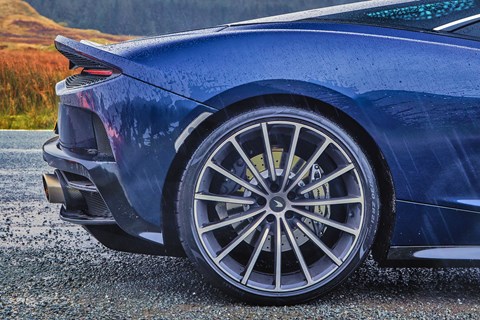
The GT is no Bentley – there’s still a hum of road noise, and the occasional mid-corner bump will thwack through the carbon structure where a Conti is far better isolated – but generally it’s a comfortable, effortless car to stroke along with its easy power and a planted, low-set feel, even when the heavens open and standing water makes progress so much trickier.
In this newly luxurious context, the gruff bass of its flatplane-crank V8 jars, and there’s squishy throttle and really quite pronounced turbo lag to work through before the turbos fling you forward, a little drum roll before the curtain raises. But if anything the pause only emphasises just how rapid the McLaren feels, the on/off turbo effect intensified by this being the lightest car on test at 1530kg, and dual-clutch gearshifts that might have had the rough edges rounded off a little to meet the GT brief, but still don’t let the engine catch its breath. Acceleration surges relentlessly as following traffic flounders in our wake.
Only the brake pedal gives real cause for complaint, with excess initial mush and tricky modulation when the pads and discs really get busy – it’s calibrated to complement gentler GT driving, but combined with the soggy turbocharged throttle, you’ll probably find crisper foot feedback playing a church organ.
The next day, rain still streaming over empty Welsh B-roads, the McLaren’s mid-engined layout, relatively low weight and punchy performance contributes to a dynamic that’s not only highly engaging, but malleable and forgiving enough to quickly build confidence too. The GT flows delicately over the road surface, steers with a measured clarity and precision that’ll later make the Honda seem sterile and the Ferrari a bit giddy and feels strikingly light and agile as it carves eagerly through corners, encouraging you to work its tyres and engine hard, confident you can coax it a little past the limits without suddenly snapping shut the throttle or stabbing at the steering in panic.
True, there’s a shade more bodyroll and less feel than with other McLarens, but the keenness of its turn-in thanks to weight being centred low and between the axles and the way it pivots around its driver like a hula-hoop are all unmistakeable signatures of a perfectly balanced sports car, no matter the extra fuzz of GT luxury, even if the nagging frustration that a 570S is a sharper, more feelsome, more agile tool persists.
So, it’s easy to fall for the McLaren GT whether you drive it at a cruise or like a cruise missile. What’s harder to fathom is whether it’s actually the correct car for this market segment. Gut feel before I jump into our rivals? I’m not sure that it is.
Ferrari Portofino: the classic GT formula
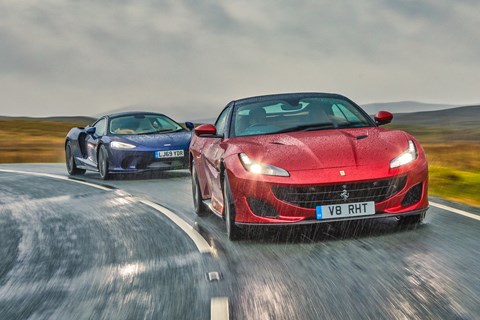
Ferrari has been doing grand tourers for far longer than its mid-engined line. So although the F8 Tributo, its entry-level mid-engined model, is an excellent two-seat supercar comfortable enough to use every day, the Portofino is closer to defining the GT breed.
A 3.9-litre twin-turbocharged V8 produces 592bhp with 561lb ft and is mounted in the nose, there are plus-two rear seats that adults can just about squash into courtesy of 5cm extra rear legroom versus the California T, and then there’s that folding hardtop that lowers in just 14 seconds at speeds up to 25mph, letting you bask in the Italian sun (or shelter from the Welsh rain) – and surely nothing better complements the GT brief than the ability to remove the roof, a pleasure denied to McLaren GT customers because of its curious rear loadbay.
You climb into the Ferrari through doors that open in the normal way, and the new central 10.25-inch infotainment screen is crisper and easier to use than the Honda or McLaren’s, and doubles as a rear-view camera with an image so clear it’s like watching HD TV – a peripheral detail maybe, but key to the Portofino’s daily driveability, though driver aids like lane-keep assist haven’t made it to Maranello yet.
The focus on usability, the position of the engine and the height of the Portofino – 20cm loftier than the NSX – means Ferrari must sacrifice some dynamic finesse at the altar of versatility against our mid-engined opposition. But it makes a damn good fist at clawing back the deficit.
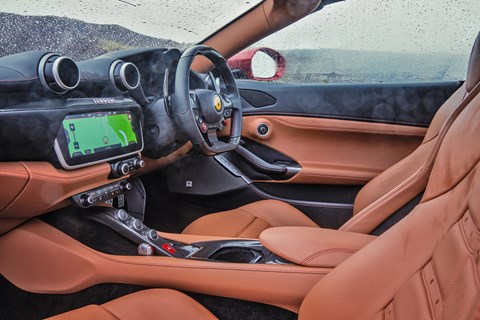
It starts with a strikingly low-set driving position, and a button-covered steering wheel much like you’ll find in any Ferrari, and with the familiar if unusually fast ratio and generous assistance. The latter gives the Portofino energy to dance off the extra kilos lying up front, even if there’s very little road surface information actually flowing through the helm – the McLaren, with its more languid ratio, offers more nuanced communication.
There’s also a highly responsive feel through the pedals, especially compared with the McLaren. Factory-fit carbon-ceramic brakes (no other car here is supplied with them as standard) have a far tauter, more immediate response, and throttle response in Sport mode is like stepping on an electric fence after the muted McLaren – though it can always be softened in Comfort.
The outright punch of the V8/dual-clutch powertrain is blunted after the more powerful, lighter McLaren and the e-boost and endless gears of the similarly powerful though heavier NSX, but what it lacks in thrust it makes up for with driver engagement. Hardly sluggish, either, as 0-62mph in 3.5 seconds and 200mph flat-out attest.
Turbo lag is non-existent (nobody has mastered forced induction like Ferrari) giving a bandwidth to the performance that begins with low-rpm flex and rises progressively towards 7500rpm almost like the good old days of natural aspiration, not the sudden turbo kick of the GT. And neither Honda nor McLaren can shift gears with quite the pop of the Ferrari – pulling the paddleshifters is more like whipping the V8 on for extra speed than changing gear, though again you can dial back the blam-blams for less Italian driving.
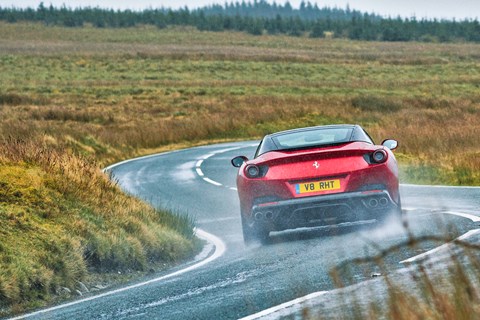
There’s a vitality to the way the Ferrari steers and revs that makes it feel lighter than it actually is, and in some ways Ferrari has approached the Portofino from the opposite end of the spectrum than McLaren in trying to make a GT feel like a sports car, not the other way round. It’s a car you drive with fingertip delicacy and gentler inputs, not scruff-of-the-neck harries, not in these conditions anyway.
In fact, the Portofino actually deploys its power well, especially given how much work the fast and reasonably soft front end asks of the rear. Partly that’s thanks to the trick e-diff carefully marshalling power, partly thanks to supple damping (courtesy of rather cheeky optional adaptive dampers here) that helps the Ferrari gather itself up neatly after crests and ride serenely over the primary undulations as our test roads take us over boggy, uneven moorland.
But it’s not perfect: play with the Ferrari more aggressively and there’s a far brisker transition to oversteer in the wet and more of a shimmy as it comes back in line. Over secondary ripples there’s also what feels like a structural shimmy from the rear.
The Portofino remains a compelling drive, and represents the car on test that best fits the grand-tourer criteria simply because nothing else here covers more bases.
Honda NSX: 20 years on, it’s still futuristic
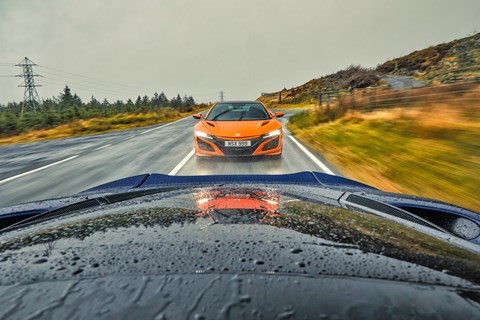
Freeze-frame the view through the NSX windscreen and you’ll see wipers working hard, water streaming over the road surface and pooling in compressions you could possibly fish in, and you’d probably want to park this near-600bhp supercar, not squash the accelerator to the floor. But press play, teleport yourself to the low-slung driver’s seat with its strong support and deep padding and I swear you’d feel confident, certainly more than in either the McLaren or the Ferrari. Cutting through standing water, getting on the power early out of corners, braking late – none of it fazes the NSX.
It’s built around a spaceframe chassis, clothed in aluminium and composites with tight panel gaps that make the McLaren look like a Cat D, and equipped with a 3.5-litre V6 boosted not only by twin turbochargers, but also three electric motors – one at the rear to boost the mid-mounted V6, a pair at the front to act on each front wheel individually for all-wheel drive and no need for a propshaft between. Ferrari’s come round to a similar idea with the upcoming SF90.
Updates new this year include a little flim-flam (including our car’s Thermal Orange Pearl paint and its Indigo Blue and black alcantara interior), and, of more substance, chassis tweaks that make things stiffer, grippier and more precise: anti-roll bars are uprated 26 per cent front, 19 per cent rear, rear toe-link bushing stiffness is up 21 per cent, rear hub rigidity climbs six per cent and the Continental SportContact 6 supersedes the previous 5P. Add in software updates for the – acronym ahoy – Sport Hybrid Super Handling All-Wheel Drive, electric steering, stability control and adaptive dampers and the new NSX is apparently two seconds swifter around Suzuka.

No extra power, mind, so the output of both fossil fuel and electrical power combined is still 573bhp and 476lb ft. But mash the throttle and this remains a searingly quick machine – sub-three quick from zero to 62mph, says Honda, a statistic validated by your internal g-meter.
The integration of petrol and electricity is seamless, the batteries filling in for any lag at low revs where the McLaren pauses, fattening out the mid-range and adding an intense, manic rush to the high notes, all of it soundtracked by a deep, angry bellow like the V6 is singing through a vocoder. Artificial perhaps, but it suits the NSX’s digital character perfectly – as does Quiet mode that lets the NSX run eerily, if briefly, silent.
A nine-speed dual-clutch auto plays its part in the NSX’s lunging acceleration, its close ratios and shifts quick enough without getting hysterical, so too the all-wheel drive, simply because you can just deploy all the power where the McLaren and Ferrari invite more tentative, progressive squeezes.
At 1776kg the NSX is the heaviest car on test by a chunk, but its performance feels significantly stronger than the Ferrari, and fit enough to give the McLaren a hard time, though it’s possible the NSX’s competence in the conditions is a subjective factor today, too.
If it all sounds like driving a simulator, the NSX has far greater depth than that. There’s still a certain sterility to the steering and at times you might notice a little tug as the e-motors act on the axle that also steers, but it’s pretty subtle and really the overwhelming feeling is one of precision and a meaty kind of consistency.

Chassis tweaks have peeled away the layer of detachment from the (albeit impressive) early cars, and what’s really noticeable in these conditions is the NSX’s playfulness, odd though that may sound given its sure-footed competence. Work the chassis hard with ambitious entry speed or early throttle and it’ll pivot around its middle and oversteer, and it’s all so benignly balanced and naturally gathered up that it quickly fosters confidence. It’s a pity traction control won’t fully disengage even in Track mode, but work with it, don’t be too abrupt, and it’ll give you enough rope to give you the full ‘Senna mastering a sodden Donington in 1993’ experience.
There are three crucial areas in which the NSX drops the ball versus our more storied group-test rivals: a badge that wilts against a £30k cheaper Audi R8, let alone Ferrari and McLaren; an interior that borrows too heavily from US-market Acuras; and a boot so tiny you’ll need to pack like a free-climber. Any of the above might prove deal-breakers, but as a car to use every day and then properly lay into over your favourite road whatever the weather? There’s an awful lot to like about the NSX.
GT vs Portofino vs NSX: final reckoning

That this test has diversity to make the BAFTAs blush is simply a by-product of McLaren busting its GT out of the grand-touring pigeonhole with an adapted mid-engined sports car made more luxurious. The McLaren’s drawbacks mostly relate to those inherent in the architecture and carry-over mechanicals – low-down two-seat layout, flatplane V8 that rumbles like a gorilla in a suit. But the GT is grand-tourer comfortable, it does feel plusher and more luxurious than its siblings, and the real payback comes with how sweetly it drives – its lightness, speed and delicacy. We like it; it’s good.
But it’s also hard to reconcile the confusion of the GT’s positioning, and we fear it may suffer the same fate as the last Lotus Europa, which re-purposed sports car bits and pieces for a ‘business class’ experience and sold poorly.
The Ferrari Portofino is the only real grand tourer in this test with its plus-two rear seats, front-mounted engine, even a folding hardtop – a convertible should at least be offered to GT customers, and Ferrari provides the best of both here, where its rivals are coupe only.
There are question marks over how together the Portofino feels when pushed really hard, but keen responses, most notably from its steering and powertrain, lend energy and alertness familiar from more overtly sporting Ferraris. And this is a more convincing car to drive regularly and take on long trips than the McLaren – even if some drivers might prefer less excitement in foul conditions.
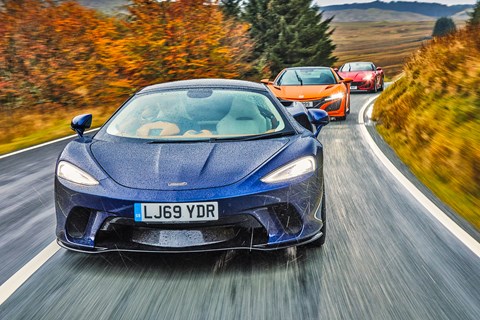
The Honda strikes the sweet spot between the McLaren and the Ferrari, its usability baked in rather than subsequently superimposed. It’s as easy to daily drive as the Portofino, awesomely secure in all weathers, vastly fast and able to run on e-power alone, if fleetingly. Then turn up the wick and the Honda’s thumping e-boosted V6, mid-engined layout and surprisingly adjustable balance blend otherworldly futurism with old-school interaction. It flatters, encourages and engages all at the same time. The boot, the badge and the Acura parts-bin interior all count against, but it’s the NSX I’d pick to do the jobs of both McLaren GT and Ferrari Portofino.
Check out more CAR magazine comparison tests